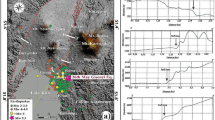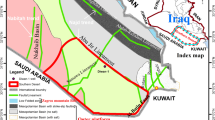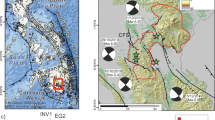Abstract
The tectonic activity in the Himalayan region is reflected through major and minor lineaments associated with the major fault and thrust systems. In the present study, we used multi-sensor optical and microwave radar remote sensing images and topographic elevation data for extraction of lineaments. Image enhancement of remote sensing data and relief shading of topographic elevation data were performed for highlighting the lineaments. Eight structural domains were selected in and around the major thrusts and strike slip faults in north-western and central Himalayan regions. From the angular distribution of lineaments, the vector mean orientations of major and minor lineaments were determined for each of the structural domains. Considering areal coverage of individual litho-units, area-weighted internal friction angles were obtained for eight structural domains. Finally, based on the Mohr-Coulomb failure criteria, the directions of maximum principal stress (s1) were estimated from the orientations of shear fractures. The study shows a good agreement between minor lineaments based maximum principal stress directions and GPS based plate motion vectors. But, we found a significant deviation between major and minor lineaments based principal stress directions and plate motion vectors for some of the structural domains those were affected by post-thrusting strike-slip fault tectonics. This is perhaps due to the fact that major lineaments give rise to the maximum principal stress direction of older collision and post-collision phases whereas minor lineaments represent essentially recent to sub-recent active tectonics phase. Further, subtle local deviations in the principal stress directions may be attributed to litho-tectonic heterogeneities.





Similar content being viewed by others
REFERENCES
É. Argand, “La tectonique de l’Asie,” Proceedings of the XIII International Geological Congress, Brussels, Belgium 1924, Vol. 1, No. 5, pp. 171‒372.
L. E. Arlegui and M. A. Soriano, “Characterizing lineaments from satellite images and field studies in the central Ebro basin (NE Spain),” Int. J. Remote Sens. 19, 3169–3185 (1998).
J. P. Avouac, “Mountain building, erosion, and the seismic cycle in the Nepal Himalaya,” Adv. Geophys. 46, 1‒80 (2003).
P. Banerjee and R. Burgmann, “Convergence across the northwest Himalaya from GPS measurements,” Geophys. Res. Lett. 29, 1652 (2002).
R. Bilham, V.K. Gaur, P. Molnar, “Himalayan seismic hazard,” Science 293, 1442‒1444 (2001).
S. Dasgupta, P. Pande, D. Ganguly, Z. Iqbal, K. Sanyal, N. V. Venkatraman, B. Sural, L. Harendranath, K. Mazumdar, S. Sanyal, A. Roy, L. K. Das, P. S. Misra, and H. Gupta, Seismotectonic Atlas of India and Its Environs, Scale 1 : 1 000 000, No. 59 of Geol. Surv. India, Spec. Publ., Ed. by P. L. Narula, S. K. Acharyya, and J. Banerjee (Geol. Surv. India, 2000).
S. A. Drury, S. P. Kelley, S. M. Berhe, R. E. Collier, and M. Abraham, “Himalayan seismic hazard”, Science 293, 1441–1444 (1994).
S. A. Drury, S. P. Kelley, S. M. Berhe, R. E. Collier, and M. Abraham, “Himalayan seismic hazard,” Science 293, 1441–1444 (1994).
J. Fagbohun, B. Adeoti, and O. O. Aladejana, “Litho-structural analysis of eastern part of Ilesha schist belt, Southwestern Nigeria,” J. Afr. Earth Sci. 133, 123‒137 (2017).
S. C. N. Fils, C. H. B. Mongo, D. G. Nkouathio, M. E. Mimba, J. Etouna, P. N. Nouck, and B. Nyeck, “Radarsat-1 image processing for regional-scale geological mapping with mining vocation under dense vegetation and equatorial climate environment, Southwestern Cameroon,” Egypt. J. Remote Sens. Space Sci. 21, 43–54 (2018).
W. Gan, P. Zhang, Z. Shen, Z. Niu, M. Wang, Y. Wan, D. Zhou, and J. Cheng, “Present-day crustal motion within the Tibetan Plateau inferred from GPS measurements,” J. Geophys. Res. 112, B08416 (2007).
Geological Map of India, Scale 1 : 2 000 000, 7th ed. (Geol. Surv. India, 1998).
R. Gloaguen, P. R. Marpu, and I. Niemeyer, “Automatic extraction of faults and fractal analysis from remote sensing data”, Nonlinear Process. Geophys. 14, 131‒138 (2007).
L. Han, Z. Liu, Y. Ning, and Z. Zhao, “Extraction and analysis of geological lineaments combining a DEM and remote sensing images from the northern Baoji loess area,” Advanc. Space Res. 62, 2480–2493 (2018).
A. Haq, S. K. Pandita, Y. Singh, G. M. Bhat, S. J. Pandey, A. Singha, M. Verma, and B. K. Bansal, “Evidence of active tectonic deformation in Kishtwar Area, Jammu and Kashmir, Northwest Himalaya, India”, J. Geol. Soc. India 93, 331–342, (2019).
J. L. Hardebeck and A. J. Michael, “Stress orientations at intermediate angles to the San Andreas Fault, California,” J. Geophys. Res.: Solid Earth 109, Art. No. B11303 (2004). https://doi.org/10.1029/2004JB003239
A. Heim and A. Gansser, Central Himalayas: Geological Observations of the Swiss Expedition of 1936, Vol. 73 of Denschr. Schweizer. Naturforsch. Ges. (1939).
S. Jade, M. Mukul, V. K. Gaur, K. Kumar, T. S. Shrungeshwar, G. S. Satyal, K. D. Rakesh, J. Saigeetha, M. B. Ananda, K. P. Dileep, and B. Souvik, “Contemporary deformation in the Kashmir-Himachal, Garhwal and Kumaon Himalaya; significant insights from 1995–2008 GPS time series,” J. Geod. 88, 539–557 (2014).
G. Jordan and B. Schott, “Application of wavelet analysis to the study of spatial pattern of morphotectonic lineaments in digital terrain models: A case study”, Remote Sens. Environ. 94, 31‒38 (2005).
F. Jouanne, J. L. Mugneir, J. F. Gamond, P. L. Fort, M. R. Pandey, L. Bollinger, M. Flouzat, and J. P. Avouac, “Current shortening across the Himalayas of Nepal,” Geophys. J. Int. 157, 1–14 (2004).
N. Kanna, S. Gupta, and K. S. Prakasam, “Micro-seismicity and seismotectonic study in Western Himalaya–Ladakh Karakoram using local broadband seismic data,” Tectonophysics 726, 100–109 (2018).
A. Karnieli, A. Meisels, L. Fisher, and Y. Arkin, “Automatic extraction and evaluation of geological linear features from digital remote sensing data using a Hough transform,” Photogramm. Eng. Remote Sens. 62, 525–531 (1996).
K. Koike, S. Nagano, and M. Ohmi, “Lineament analysis of satellite images using a Segment Tracing Algorithm (STA),” Comput. Geosci. 21, 1091‒1104 (1995).
J. Lavé and J. P. Avouac, “Active folding of fluvial terraces across the Siwalik Hills, Himalayas of central Nepal”, J. Geophys. Res.: Solid Earth 105, 5735– 5770 (2000).
S. B. Mabee, K. C. Hardcastle, and D. W. Wise, “A method of collecting and analyzing lineaments for regional-scale fractured bedrock aquifer studies,” Groundwater 32, 884–894 (1994).
J. N. Malik and T. Nakata, “Active faults and related Late Quaternary deformation along the Northwestern Himalayan Frontal Zone, India,” Ann. Geophys. 46, 917‒936 (2003).
J. N. Malik, A. A. Shah, A. K. Sahoo, B. Puhan, C. Banerjee, D. P. Shinde, N. Juyal, A. K. Singhvi, and S. K. Rath, “Active fault, fault growth and segment linkage along the Janauri anticline (frontal foreland fold), NW Himalaya, India,” Tectonophysics 483, 327–343 (2010).
U. Mallast, R. Gloaguen, R. S. Geyer, T. Rödiger, and C. Siebert, “Derivation of groundwater flow-paths based on semi-automatic extraction of lineaments from remote sensing data,” Hydrol. Earth Syst. Sci. 15, 2665–2678 (2011).
J. Meixner, J. C. Grimmer, A. Becker, E. Schill, and T. Kohl, “Comparison of different digital elevation models and satellite imagery for lineament analysis: Implications for identification and spatial arrangement of fault zones in crystalline basement rocks of the southern Black Forest (Germany),” J. Struct. Geol. 108, 256–268 (2018).
B. Mukhopadhyay, A. Acharyya, D. Bhattacharyya, S. Dasgupta, and P. Pande, “Seismotectonics at the terminal ends of the Himalayan Arc,” Geomatics, Nat. Haz. Risk 2, 159‒181 (2011).
B. Mukhopadhyay and S. Dasgupta, “Seismic hazard assessment of Kashmir and Kangra valley region, Western Himalaya, India,” Geomatics, Nat. Haz. Risk 6, 149–183 (2015).
T. Nakata and Y. Kumahara, “Active faulting across the Himalaya and its significance in the collision tectonics,” Active Fault Res. 22, 7‒16 (2002).
T. Nakata, K. Otsuki, and S. H. Khan, “Active faults, stress field, and plate motion along the Indo Eurasian plate boundary,” Tectonophysics 181, 83‒95 (1990).
S. J. Pandey, G. M. Bhat, S. Puri, N. Raina, Y. Singh, S. K. Pandita, M. Verma, B. K. Bansal, and A. Sutar, “Seismotectonic study of Kishtwar region of Jammu Province using local broadband seismic data,” J. Seismol. 21, 525‒538 (2016).
L. P. Paudel and K. Arita, “Tectonic and polymetamorphic history of the Lesser Himalaya in Central Nepal,” J. Asian Earth Sci. 18, 561‒584 (2000).
R. J. Phillips, “Geological map of the Karakoram fault zone, Eastern Karakoram, Ladakh, NW Himalaya”, J. Maps 4 (1), 21‒37 (2008).
P. M. Powers, R. J. Lillie, and R. S. Yeats, “Structure and shortening of the Kangra and Dehra Dun reentrants, Sub-Himalaya, India,” Geol. Soc. Am. Bull. 110, 1010–1027 (1998).
C. Robinson, “Evidence against Quaternary slip on the northern Karakorum fault suggests kinematic reorganization at the western end of the Himalayan-Tibetan orogeny,” Earth Planet. Sci. Lett. 286, 158–170 (2009).
P. K. Sahoo, S. Kumar, and R. P. Singh, “Neotectonic study of Ganga and Yamuna tear faults, NW Himalaya, using remote sensing and GIS,” Int. J. Remote Sens. 21, 499‒518 (2000).
S. Sahoo and J. N. Malik, “Active fault topography along Kangra Valley Fault in the epicentral zone of 1905 Mw7.8 earthquake NW Himalaya, India,” Quat. Int. 462, 90‒108 (2017).
M. P. Searle, R. F. Weinberg, and W. J. Dunlap, “Transpressional tectonics along the Karakoram fault zone, northern Ladakh: Constraints on Tibetan extrusion, continental transpressional and transtensional tectonics,” in Continental Transpressional and Transtensional Tectonics, Vol. 135 of Geol. Soc. London, Spec. Publ., Ed. by R. E. Holdsworth, R. A. Strachan, and J. F. Dewey (London, 1998), pp. 307‒326.
R. P. Silver, M. A. Murphy, M. H. Taylor, J. Gosse, and T. Baltz, “Neotectonics of the Western Nepal Fault System: Implications for Himalayan strain partitioning,” Tectonics 34, 2494–2513 (2015).
S. Solomon and W. Ghebreab, “Lineament characterization and their tectonic significance using Landsat TM data and field studies in the central highlands of Eritrea,” J. Afr. Earth Sci. 46, 371–378 (2006).
R. Sorkhabi, “The Great Himalayan earthquakes,” Himalayan J. 62, Art. No. 5 (2006).
V. L. Stevens and J. P. Avouac, “Millenary M W > 9.0 earthquakes required by geodetic strain in the Himalaya,” Geophys. Res. Lett. 43, 1118–1123 (2016).
M. Taylor and A. Yin, “Active structures of the Himalayan-Tibetan orogen and their relationships to earthquake distribution, contemporary strain field, and Cenozoic volcanism,” Geosphere 5 (3), 199–214 (2009).
V. C. Thakur, R. Jayangondaperumal, and V. Joevivek, “Seismotectonics of central and NW Himalaya: Plate boundary–wedge thrust earthquakes in thin- and thick-skinned tectonic framework,” in Crustal Architecture and Evolution of the Himalaya–Karakoram–Tibet Orogen, Vol. 481 of Geol. Soc. London, Spec. Publ., Ed. by R. Sharma, I. Villa, and S. Kumar (London, 2018), pp. 41‒63.
J. Townend and M. D. Zoback, “Stress, strain, and mountain building in Central Japan”, J. Geophys. Res.: Solid Earth 111, Art. No. B03411 (2006). https://doi.org/10.1029/2005JB003759
M. Verma and B. K. Bansal, “Active fault research in India: achievements and future perspective,” Geomatics, Nat. Haz. Risk 7, 65‒84 (2016).
J. Wang and P. J. Howarth, “Use of the Hough transform in automated lineament detection,” IEEE Trans. Geosci. Remote Sens. 28, 561‒566 (1990).
W. L. Weerasekera, B. B. Mayadunna, I. P. Senanayake, and D. M. D. O. K. Dissanayake, “Integrated remote sensing and GIS in lineament mapping for groundwater exploration – a case study in Ambalantota, Sri Lanka,” SAITM Research Symposium on Engineering Advancements, Malabe, Sri Lanka, 2014, pp. 62‒65.
S. G. Wesnousky, S. Kumar, R. Mohindra, and V. C. Thakur, “Uplift and convergence along the Himalayan frontal thrust,” Tectonics 18, 967–976 (1999).
V. Wise, L. T. Grady, and F. Salvini, “Topographic lineament domains of the Appalachians. Sorne new methods and techniques for paleostress analysis,” International Geoscience and Remote Sensing Symposium, Amherst, Mass., 1985 (1985), pp. 125‒130.
R. S. Yeats and V. C. Thakur, “Reassessment of earthquake hazard based on a fault-bend fold model of the Himalayan plate-boundary fault,” Current Sci. 74, 230‒233 (1998).
J. Zhang, M. Santosh, X. Wang, L. Guo, X. Yang, and B. Zhang, “Tectonics of the northern Himalaya since the India–Asia collision,” Gondwana Res. 21, 939–960 (2012).
P. Z. Zhang, Z. Shen, M. Wang, W. Gan, R. Bürgmann, P. Molnar, Q. Wang, Z. Niu, J. Sun, J. Wu, S. Hanrong, and Y. Xinzhao, “Continuous deformation of the Tibetan Plateau from global positioning system data,” Geology 32, 809–812 (2004).
Landsat 5 TM (September 1, 2016), Landsat 8 OLI. https://earthexplorer.usgs.gov. Accessed March 21, 2014.
Resourcesat LISS-III. https://earthexplorer.usgs.gov. Accessed March 18, 2013.
Digital Terrain Elevation Data Level 2 regional DEM (SRTM 30m.) https://earthexplorer.usgs.gov. Accessed April 13, 2017.
Radar wide-swath ScanSAR images (RADARSAT 2 ScanSAR).https://mdacorporation.com/geospatial/ international/satellites/RADARSAT-2. Accessed March 18, 2013.
RISAT-1 Medium Resolution ScanSAR. https://uops.nrsc.gov.in. Accessed March 10, 2014.
Centre of Remote Sensing.https://uops.nrsc.gov.in. Accessed March 12, 2014.
ACKNOWLEDGMENTS
The authors acknowledge the contributions of Mr. Shashi Kumar Gaurav and Mr. Rohit Kumar Singh, and M.Tech. students, IIRS (ISRO) (Dehradun, India) for their help in data preparation.
The authors are grateful to reviewers Dr. L.P. Imaeva (Institute of the Earth’s Crust, Siberian Branch of RAS, Irkutsk, Russia) and Prof. E.A. Rogozhin (Schmidt Institute of Physics of the Earth, RAS, Moscow, Russia) for comment, and M.N. Shoupletsova (Geological Institute, RAS, Moscow, Russia) for editing.
Funding
The study was funded by Indian Space Research Organization (ISRO) under the Earth Observation Application Mission (EOAM) project scheme.
Author information
Authors and Affiliations
Corresponding author
Rights and permissions
About this article
Cite this article
Nath, S., Chatterjee, R.S., Mohanty, S.P. et al. Analysis of the Maximum Principal Stress Directions in the Himalayas: A Remote Sensing Based Approach. Geotecton. 55, 83–93 (2021). https://doi.org/10.1134/S0016852121010088
Received:
Revised:
Accepted:
Published:
Issue Date:
DOI: https://doi.org/10.1134/S0016852121010088




